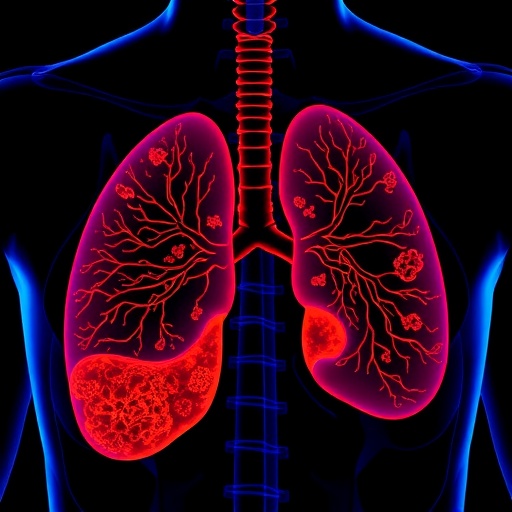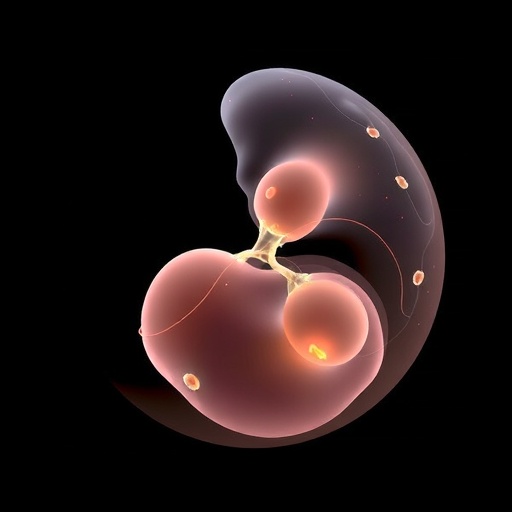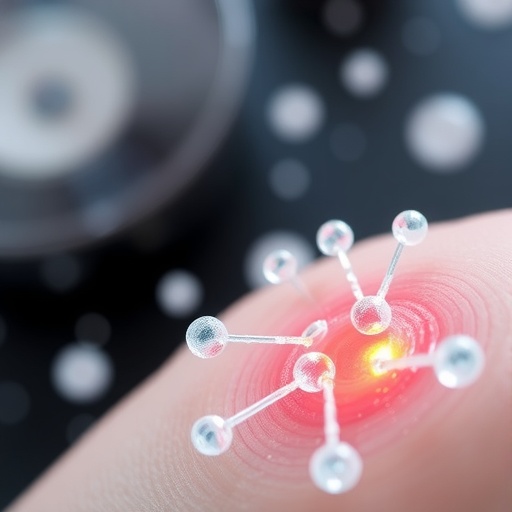PROTECT YOUR DNA WITH QUANTUM TECHNOLOGY
Orgo-Life the new way to the future Advertising by AdpathwayIn a groundbreaking study that promises to reshape our understanding of radioresistance in non-small cell lung cancer (NSCLC), researchers have identified a critical molecular interplay that fortifies cancer cells against radiation therapy. The study, led by Pu, Chen, Dong, and colleagues, reveals how the protein FHL2 (Four and a Half LIM Domains 2) amplifies ITGB1-mediated extracellular matrix (ECM) remodeling and cellular stiffness, thereby promoting resistance to radiation treatment. This discovery not only provides fresh insight into the physical and biochemical factors that underpin tumor resilience but also opens potential new therapeutic avenues for combating one of the most stubborn forms of lung cancer.
NSCLC is notoriously difficult to treat due to its high tendency to develop resistance to conventional therapies, including radiation. Historically, much of the focus has been on genetic mutations and signaling pathways conferring this resistance. However, burgeoning evidence suggests that the mechanical properties of the tumor microenvironment—how stiff or malleable cancer cells and their extracellular surroundings are—play an equally critical role. This new study delves into this biomechanical dimension, highlighting how cellular stiffness and ECM remodeling are manipulated at a molecular level to fortify NSCLC cells.
Central to this process is ITGB1 (Integrin Beta-1), a protein best known for mediating cellular adhesion to the ECM. Integrins such as ITGB1 serve as transmembrane receptors that link the ECM to the cytoskeleton, enabling cells to sense their physical environment and respond accordingly. ITGB1 activation can lead to ECM remodeling, effectively altering the scaffold upon which cells grow and interact. The study demonstrates that FHL2 enhances this activity, acting as a molecular amplifier that increases ITGB1’s impact on ECM transformation and cellular rigidity.
The research uncovers that FHL2 does more than just support ITGB1 function; it modulates the downstream signaling pathways that regulate cytoskeletal dynamics. This, in turn, alters the biomechanical properties of tumor cells—stiffening their membranes and toughening their structural framework. By stiffening cellular architecture, FHL2-driven mechanisms create a protective barrier against radiation-induced damage. This suggests that the physical state of the tumor contributes significantly to the effectiveness of radiotherapy, an insight that upends the traditional focus solely on biochemical and genetic factors.
Further mechanistic exploration revealed that disrupting the FHL2-ITGB1 axis yielded a marked decrease in ECM remodeling and reduced cellular stiffness, thereby sensitizing NSCLC cells to radiation. These findings emphasize that the mechanical reinforcement provided by this protein duo is a critical determinant of radioresistance. Intriguingly, the study also delves into the ECM composition itself, noting that the intensified remodeling alters collagen fiber alignment and density, which collectively contribute to an even more rigid extracellular environment.
Delving deeper into the downstream pathways, the research team identified that FHL2’s enhancement of ITGB1 signaling leads to activation of focal adhesion kinase (FAK) and Rho-associated protein kinase (ROCK), key regulators of cytoskeletal tension and contractility. These signaling cascades promote cellular contraction forces, directly influencing cell stiffness and further reinforcing resistance to radiation damage. The interplay among FHL2, ITGB1, FAK, and ROCK forms a robust biomechanical circuit that cancer cells exploit to survive harsh therapeutic conditions.
This paradigm shift in understanding radioresistance has profound clinical implications. By targeting the FHL2-ITGB1 axis or the downstream mechanotransduction pathways, it may be possible to disrupt the stiffness-enhancing feedback loop, rendering tumor cells more vulnerable to radiotherapy. This could allow for dose reductions in radiation, minimizing collateral damage to healthy tissue while maximizing tumoricidal efficacy. Small molecules or biologics that specifically inhibit FHL2 expression or interfere with its interaction with ITGB1 present exciting candidates for future drug development.
Sophisticated biophysical assays conducted alongside molecular experiments validated the biomechanical properties of the cancer cells after modulation of FHL2 and ITGB1. Atomic force microscopy measurements showed a significant reduction in Young’s modulus—a measure of cellular stiffness—when FHL2 was silenced, confirming the protein’s role in mechanical reinforcement. Complementary microscopy images depicted changes in ECM morphology, with less collagen fiber bundling and alignment in FHL2 knockdown conditions, underscoring the interplay between intracellular and extracellular components in generating rigidity.
In addition to lab-based insights, the research included analysis of patient tumor samples, confirming higher expression of FHL2 and ITGB1 in radioresistant NSCLC specimens compared to those responsive to radiation. This translational evidence affirms the relevance of the FHL2-ITGB1 axis in clinical disease and suggests that FHL2 and ITGB1 levels could serve as predictive biomarkers for radiotherapy response, enabling personalized treatment strategies.
The discovery calls for renewed interrogation of the tumor microenvironment’s mechanical landscape in cancer therapies. Traditionally viewed as a passive backdrop, the ECM and cellular physical properties emerge here as active participants influencing treatment outcomes. Importantly, the data also suggest that ECM remodeling and increased stiffness contribute to cancer progression and metastasis, compounding their impact beyond resistance alone. This integrated understanding encourages the design of multimodal treatment regimens combining biomechanical modulators with cytotoxic therapies.
From a therapeutic innovation standpoint, nanoparticle-based delivery systems could be adapted to convey inhibitors directly to the tumor ECM or cytoskeletal regulatory nodes, enhancing precision and reducing off-target effects. Moreover, synergistic drug combinations that concurrently disrupt FHL2-ITGB1 interaction, block FAK/ROCK signaling, and modulate ECM architecture might achieve superior outcomes in resistant NSCLC cases. These strategies underscore the importance of integrating mechanobiology into drug discovery pipelines.
On a conceptual level, the study challenges researchers to think holistically about cancer cell survival strategies, encompassing biochemistry, genetics, and mechanics as interwoven facets rather than isolated silos. The FHL2-ITGB1 axis exemplifies this multidimensional interplay, where physical forces and molecular signaling cooperate to shape tumor fate. This deeper appreciation of tumor biology promises fertile ground for novel discoveries that could dramatically improve patient prognoses.
Looking ahead, further investigations are needed to untangle the precise molecular interfaces by which FHL2 modulates ITGB1 and how other extracellular components contribute to this biomechanical resistance network. Given the diversity of ECM constituents in different tumor types, comparative analyses may reveal cancer-specific mechanisms or universal principles governing radioresistance. Such knowledge could extend the applicability of these findings beyond NSCLC to other solid malignancies exhibiting similar stiffening phenomena.
In conclusion, the study by Pu and colleagues heralds a new era in cancer biology where the mechanical reinforcement of tumor cells via FHL2-amplified ITGB1-mediated remodeling profoundly influences therapeutic resistance. This discovery simultaneously enriches our molecular understanding and offers tangible therapeutic targets, highlighting the vital importance of blending mechanistic insight with clinical application. As researchers and clinicians harness this knowledge, the prospects for overcoming radioresistance in NSCLC—and potentially other cancers—appear significantly brighter.
Subject of Research: The molecular and biomechanical mechanisms underlying radioresistance in non-small cell lung cancer, focusing on the roles of FHL2 and ITGB1 in ECM remodeling and cellular stiffness.
Article Title: FHL2 enhances ITGB1-mediated ECM remodeling and cellular stiffness to promote radioresistance in non-small cell lung cancer.
Article References:
Pu, X., Chen, K., Dong, L. et al. FHL2 enhances ITGB1-mediated ECM remodeling and cellular stiffness to promote radioresistance in non-small cell lung cancer. Cell Death Discov. 11, 480 (2025). https://doi.org/10.1038/s41420-025-02757-6
Image Credits: AI Generated
DOI: https://doi.org/10.1038/s41420-025-02757-6
Tags: cancer resilience factorscellular stiffness in tumorsECM and cancer treatmentFHL2 ITGB1 signaling pathwayFHL2 lung cancer radioresistanceITGB1 integrin beta-1 rolemolecular interactions in cancer cellsnon-small cell lung cancer ECM remodelingradiation therapy resistance mechanismsradioresistance in NSCLCtherapeutic targets for lung cancertumor microenvironment biomechanics


 9 hours ago
14
9 hours ago
14





















 English (US) ·
English (US) ·  French (CA) ·
French (CA) ·